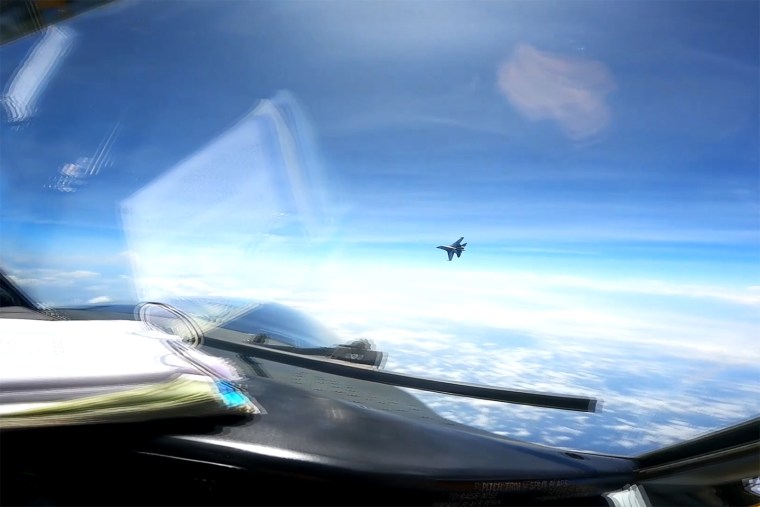A Chinese fighter jet flew directly in front of the nose of a U.S. reconnaissance plane over the South China Sea on Saturday, the Defense Department said Tuesday, another in a rising number of incidents involving Chinese military aircraft and ships.
The “unnecessarily aggressive maneuver” by the Chinese J-16 forced the U.S. RC-135 to fly through the fighter jet’s wake turbulence, according to the Pentagon, which released video of the encounter.
The Pentagon said that the U.S. plane was “conducting safe and routine operations … in international airspace, in accordance with international law.”
On Wednesday, Secretary of State Antony Blinken said that the "Chinese pilot took dangerous action in approaching the plane very, very closely. There have been a series of these actions directed not just at us, but in other countries in recent months."
Late Monday, the Pentagon reported that China had rejected a U.S. request for Defense Secretary Lloyd Austin to meet with his Chinese counterpart in Singapore. The Pentagon had suggested a meeting between Austin and Li Shangfu on the sidelines of the Shangri-La Dialogue, an annual security forum held from June 2 to June 4.
Blinken said the Saturday incident "underscores why it is so important that we have regular open lines of communication, including by the way between our defense ministers. It’s regrettable that the meeting that Secretary Austin sought did not go forward."
"The most dangerous thing is not to communicate and as a result, to have a misunderstanding and miscommunication. And as we’ve said repeatedly while we have a real competition with China, we also make sure that doesn’t veer into into conflict and the most important starting point for that are regular lines of communication."
“We have seen an alarming increase in the number of risky aerial intercepts and confrontations at sea by PLA aircraft and vessels,” a senior Defense Department official said, using the initials for China’s People’s Liberation Army. “As leaders have said, actions such as these have the potential to create an unsafe incident or miscalculation.”

A spokesperson for U.S. Indo-Pacific Command said that U.S. concerns about the interaction “will be addressed through the appropriate, established diplomatic and military channels.”
On Wednesday, Chinese Foreign Ministry spokesperson Mao Ning said frequent U.S. naval and aerial surveillance in the region had long endangered China’s national security.
“Such provocative and dangerous actions are the root cause of maritime security problems,” she said at a regular news briefing in Beijing.
Mao said China will “continue to take necessary measures” to protect its sovereignty and security.
Past incidents
In February, a Chinese J-11 fighter jet appeared about 500 feet off the left wing of an American P-8 Poseidon maritime patrol aircraft and remained for well over an hour. The U.S. plane was flying above mostly uninhabited islands that are claimed by both China and its neighbors.

A voice from a Chinese military ground station warned the U.S. plane, “No approaching any more or you will pay full responsibility.”
In December 2022, a Chinese plane passed within 10 feet of a U.S. aircraft.
Two months ago, China’s military said that it had driven away the USS Milius after the U.S. guided missile destroyer “illegally intruded into China‘s Xisha territorial waters without the approval of the Chinese government.” The U.S. said the ship was conducting routine operations and was not expelled.
